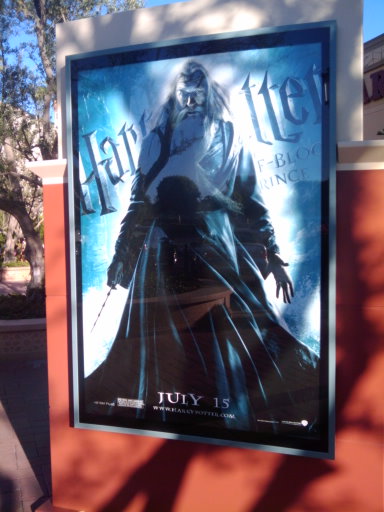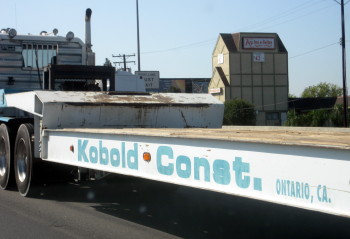
Go ahead. Tell me Dumbledore doesn’t look like Gandalf in this poster.

Go ahead. Tell me Dumbledore doesn’t look like Gandalf in this poster.
Listening to “Into the West” (end credits song from Lord of the Rings: Return of the King). Lyric, “Across the sea a pale moon rises.”
It’s all about crossing the sea into the west to go to elf heaven. Presumably the speaker is standing at the Grey Havens, waiting for the ships to arrive and carry her off to the Undying Lands, looking across the sea…to the west.
So since when does the moon rise in the west?
Admittedly, it’s a fantasy setting, but Middle Earth is set up to be a mythical past for the real world, so I’m fairly certain the sun and moon still rise in the east…
Something like 10 years ago, Katie saw a self-storage place in which the opening S was unlit, making it read, “Elf Storage.” She’s been looking for another one ever since, and we finally caught one in Newport Beach a few months ago. This one was even better, because the S had actually fallen off.

Of course, there are other things in the area that could easily come out of a Dungeons & Dragons manual. Such as this Kobold Construction truck.

And then there’s the fact that all fire engines in Orange County are labeled ORC.

Let’s not forget the previously-blogged Hobbit Center in Laguna Beach.

And that’s not even getting into all the Tolkien-inspired street names in Lake Forest…
On the subject of filk, and trying to define it, there’s a whole subset of songs by professional musicians that just rides the edge. (Half of “Weird Al” Yankovic’s repertoire, for instance.) Twice in the last week I’ve heard Led Zeppelin’s “Ramble On,” which is apparently about Aragorn and Arwen from Lord of the Rings. It even makes references to Mordor and Gollum in the lyrics.
I’m not sure I’d ever heard it before, but Train covered it at the concert we went to last Friday (we went for the Wallflowers, who played after the intermission), and I just heard it on the radio this morning.
Talk about timing.
After a year, DM of the Rings is finished. The comic recast Lord of the Rings as a Dungeons & Dragons campaign, using stills (sometimes brilliantly chosen) from the Peter Jackson–directed movie trilogy in a comic-strip format.
The series poked fun at RPG tropes and player types, with the players’ dialog given to the LOTR characters. Every once in a while, someone would speak in character. But mostly, they’d be asking about the Cheetos, or why there wasn’t enough loot. And speaking of loot, it also pointed out where the story would fall down as a game.
Anyway, cartoonist Shamus Young has already started his next project, this time with artist Shawn Gaston: The webcomic Chainmail Bikini: The Nightmare Legend of Deuce Baaj started today. From the first strip, it looks to be covering the same territory—foibles of role-playing games—this time explored through an original story. It’s not clear where the title comes in, though.

Update Dec. 2008: Chainmail Bikini ended in May 2008, and seems to have been taken down. Sorry to all of the people looking for it and landing on this page.
Sunday at SDCC was, oddly, more crowded than Saturday. Maybe it was the desperation of the last day combined with the fact that it was still on the weekend. We got in later, closer to 11:30, since we spent the morning packing.
I did a final round of back-issue hunting, and ended up not buying anything. All the Golden Age Flash books were high-grade, and therefore out of my price range. Unfortunately I forgot to check eBay this morning, because several auctions I’d put off bidding on ended before we got home.
I hit two panels: First Fables, which was basically the entire creative team of the book and the spinoff, Jack of Fables, and was great fun. They also announced the upcoming “burning questions” issue. They’ll take questions from readers, and put together a bunch of one– or two-page stories to answer them.
The other panel was for Lord of the Rings. People from New Line Home Video, EA Games, Games Workshop, and Topps Cards all talked about their new tie-ins. At least, they did after the 15-minute attempt to get the screen properly hooked up to both the DVD player and the laptop. I’m annoyed that they’re releasing another DVD edition (this set has the theatrical version and the extended version on one double-sided disc—no, they’re not making more changes to the films, thank the Eldar), but the Battle for Middle Earth II expansion pack, Rise of the Witch-King, looks pretty cool. Too bad I’m not any good at real-time strategy games.
We left the con around 4:00, had dinner back in Little Italy, then got on the road around a quarter to six. 2½ hours later, we were home.
It’s odd how quickly you get used to the walking. After the first day, my feet were sore from walking and my shoulders were sore from carrying my backpack. They were still bad the next morning, but better by evening, and by the third day, they were perfectly fine. (Well, except for the blister on my toe.)
Still, I think I’m going to be a zombie at work tomorrow. Next year, it might be worth taking the following Monday off as well.
Anyway, stay tuned. I’ll be posting photos (cosplay, weirdness, and possibly sightseeing)—and with any luck, quotes as well—sometime in the next few days.
Apparently the movie industry is trying to come up with an ad campaign to get people back into theaters. The LA Times doesn’t seem to take the idea terribly seriously, as they’ve suggested the slogan, “Movies: Just like DVDs, but Larger.” Meanwhile, theaters and studios are blaming each other for the decline in attendance:
Theater owners blamed Hollywood for making inferior (and overly long) movies, studios worried that theaters were turning the multiplex (with its barrage of pre-show commercials) into as much of an ordeal as an escape.
How do you figure out who’s right? Oh, wait, that’s easy: Both of them.
Make better movies, and more people will brave the long lines, high prices, 20 minutes of annoying big-screen commercials, 15 minutes of previews for movies that aren’t terribly interesting, people yakking on cell phones, people narrating the entire @%!# movie for their friends 30 seconds ahead of the action, etc.
Clean up the theater experience, and people will be willing to go for movies that look kinda interesting instead of really interesting.
It’s not just the big screen and immersive sound. Watching Serenity at home lacked the intensity of watching it in a theater full of fans (even the second time, when we knew what to expect). Neither canned laughter nor a studio audience can compare to dozens or hundreds of people laughing together in the same room. And it’s hard to match the collective “Oh, $#!7” that swept the theater in each showing of Return of the King when Shelob showed up again after Frodo thought he had escaped. The communal experience strikes a chord that you just can’t reach with a couple of people and a TV set.
People who talk through the entire movie aren’t just distracting you from the movie, they’re interfering with that communal experience. There’s only so much theater staff can do, short of kicking people out, but at least we know in the future they’ll get to inhabit a special level of Hell. 😈